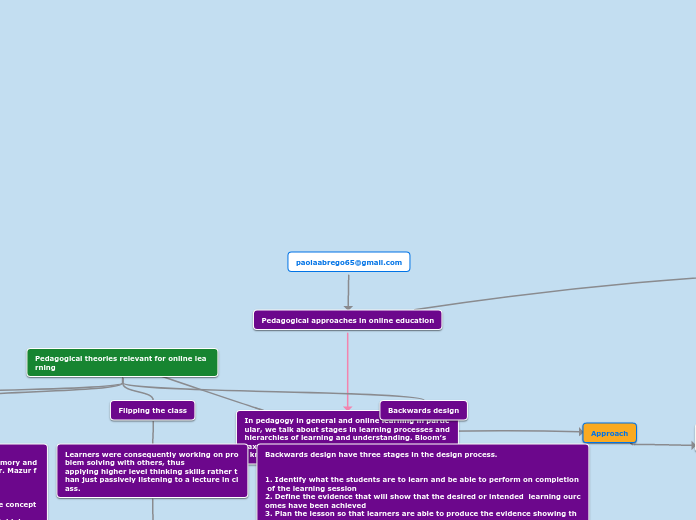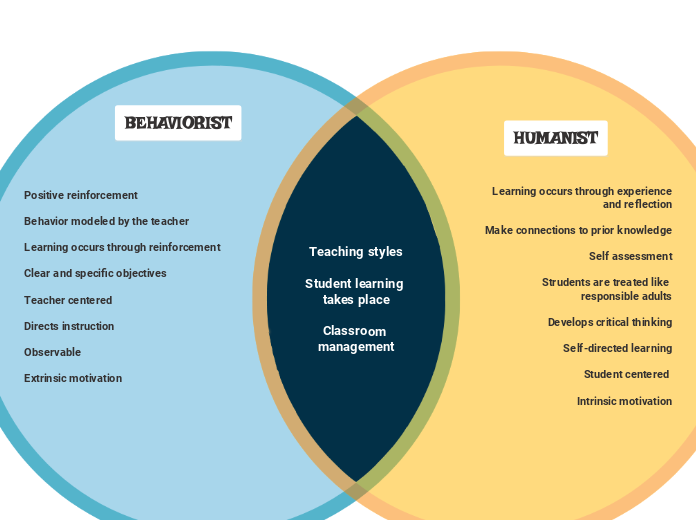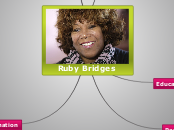paolaabrego65@gmail.com
Pedagogical approaches in online education
Choosing the pedagogical approach
The 4 Cs: Four key qualities for the Information Age: Be Creative, efficient Communicator, Critical thinker and Collaborator
In pedagogy in general and online learning in particular, we talk about stages in learning processes and hierarchies of learning and understanding. Bloom’s taxonomy is a classic example of such a hierarchy of knowledge.
Pedagogical theories relevant for online learning
Backwards design
Backwards design have three stages in the design process.
1. Identify what the students are to learn and be able to perform on completion of the learning session 2. Define the evidence that will show that the desired or intended learning ourcomes have been achieved 3. Plan the lesson so that learners are able to produce the evidence showing that the intended learning outcomes have been achieved. Various learning activities leading to appropriate reification are usually neede
Flipping the class
Learners were consequently working on problem solving with others, thus applying higher level thinking skills rather than just passively listening to a lecture in class.
Typical for the flipped classroom are
learners actively engage in the learning process learners apply what they learned from watching the video lesson learners may review content by repeating the video lecture
learners receive personal assistance and attention needed to proceed to the next level of understanding learners learn from each other instructors guide in the learning process
Peer instruction
Students tend to store the information in their short term memory and forget it all when the exam is over. Mazur found that when he asked the students to form dyads – groups of two – and instructed them to explain the concept to be learned to each other, learning retention was much highe
Cognitive load theory
The theory claims that learners have a limited working or short term memory, but an unlimited longterm memory
Approach
Social constructivism or sociocultural pedagogy
Social constructivism means that the students join a knowledgegenerating community; a community of practice (CoP), and in collaboration with others solve real problems and assignments in an authentic context as part of their study.
Constructivism is as a rule timeconsuming and demanding. Best suited for resourceful and independent students.
focus is more on the group and group learning than on the individual.
It is much easier to keep up the study motivation together with others. Communication skills improve. The student uses the information gathered by formulating and stating arguments. The knowledge gained is actively used and modified in confrontation with the opinions of others, and thus understanding and insight increase with the discussions.
Constructivism
It is timeconsuming to find out by trial and error, going to the library, asking various people etc. There is a real danger of developing completely individual systems which in some cases may be useful and creative, but often are idiosyncratic; i.e. too individual to be communicated to others. Focus is on the individual or the individual learning in interaction with others
The student develops independence and creativity; s/he learns to be critical when choosing his/her resources. The problems or tasks are authentic, and the student as a rule sees that what s/he learns can be applied in the real world. The learning is contextualise
The constructivist approach argues that people have to be active learners and construct knowledge themselves based on what they already know. The knowledge is seen as more subjective, dynamic and expanding rather than objective and static. The main tasks here are processing and understanding of information, making sense of the surrounding world
Instructivism or behaviourism ’in a nutshell’
Behaviouristic instruction
Strengths
• Time is not wasted on understanding why it is correct.
• Basic knowledge such as learn how to read, write, do simple calculations, grammar etc. can be efficiently taught by cramming, drilling, repetitions and tests.
• They also do not have to learn the difference between poisonous and edible mushrooms by trial and error.
• Discipline and correct individual behaviour in the learning situation are important values. It is fairly easy to control curriculum and content
Weaknesses
You also get people who depend on instructions from somebody ”who knows” to lead, motivate and correct
Critical, independent thinking and acting are often weak points. You risk getting people who without objections accept instructions, or what is written.
Many students focus on strategic, shallow learning, just learning the stuff necessary to get good grades on the tests.
Itis a traditional way of education delivery. Emphasis is on the transmission of theoretical units of information in a traditional classroom situation: The teacher in front lectures the students facing the teacher. There might be opportunities for dialogue between a student and the teacher
What is more efficient:
a) learning by heart, drilling, study a text for the sake of studying, testing etc or b) active problemsolving, activities building up insight and understanding, critical reflexion?
The answer is probably: It depends. If you want your students to learn irregular French verbs, some types of theoretical maths and the latin names of plants and animals, you might consider the instructivist method.









